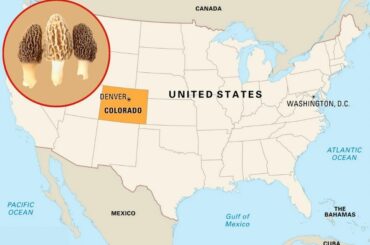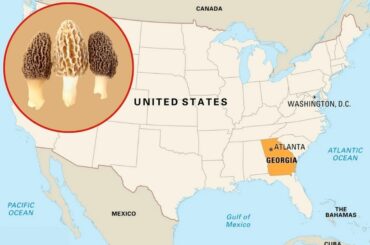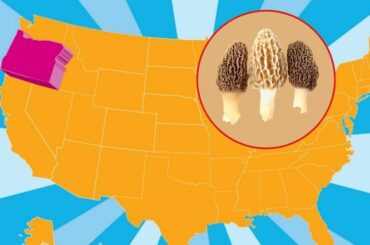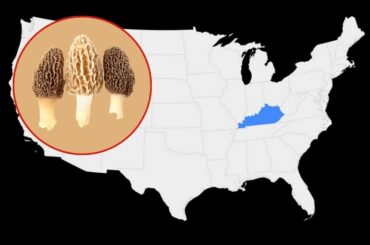Is Indigo Milk Cap Edible? Yes. Indigo milk cap is a small mushroom that can be eaten fresh or canned. Some people say that this mushroom has a nutty taste. The Indigo Milk Cap is safe to eat as long as it is cooked properly. Although mushrooms are well-loved food among everyone, many do not prefer to eat mushrooms with odd colors.
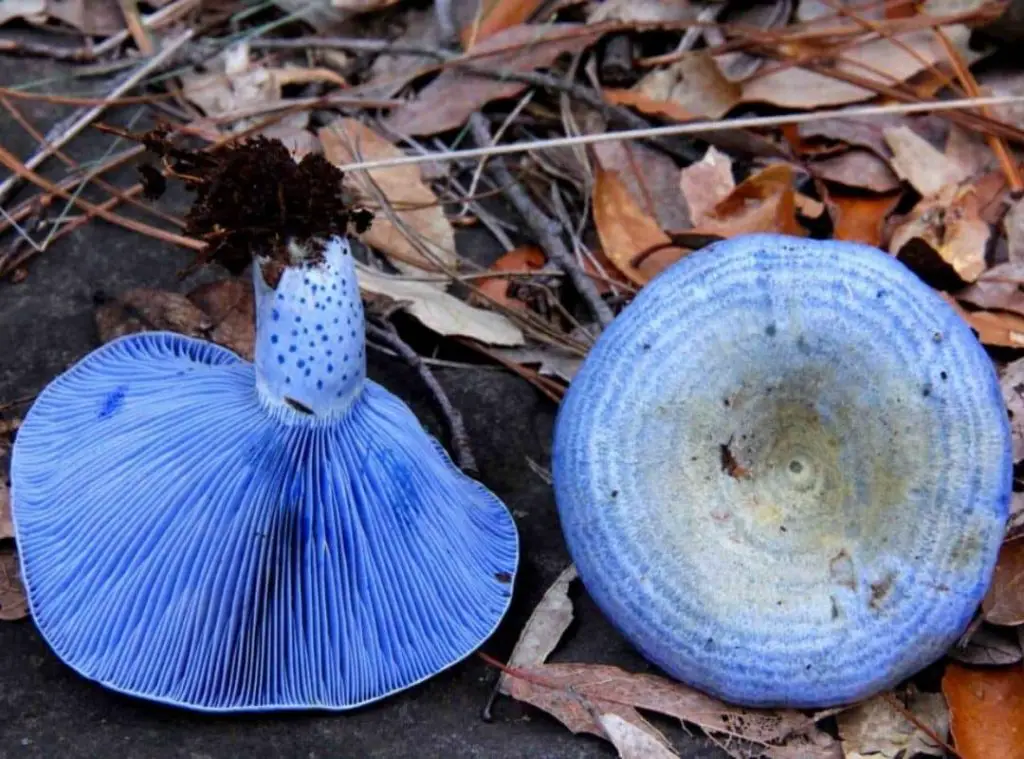
People prefer pure white and light brown in mushrooms because these colors look like they would be safe to eat. However, this is not always the case. For example, some mushrooms are black but are safe to eat. The same goes for blue and purple mushrooms. Knowing that the Indigo milk cap is edible isn’t enough unless you know when and where to find it. This article will guide you through that.
What is an Indigo Milk Cap?
Contents
- 1 What is an Indigo Milk Cap?
- 2 Where can I find indigo milk caps?
- 3 How can I identify an Indigo Milk Cap?
- 4 When can I find indigo milk caps?
- 5 Why are indigo milk caps blue?
- 6 Can you eat an indigo milk cap?
- 7 Is the blue milk cap mushroom poisonous?
- 8 What does an indigo milk cap taste like?
- 9 How do you cook indigo milk caps?
- 10 Do cooked indigo milk cap mushrooms retain their blue color?
- 11 Can you eat indigo milk caps raw?
- 12 What is the nutritional value of indigo milk caps?
- 13 Are there any side effects to eating indigo milk caps?
- 14 Indigo milk cap mushroom preservation
- 15 Where can I buy indigo milk caps?
- 16 Do indigo milk caps have look-alikes?
- 17 More interesting facts about Indigo Milk Caps
- 18 Related questions
- 19 Do indigo milk caps taste like portobello?
- 20 Conclusion
The Lactarius indigo, also called the Indigo Milk Cap, is a small mushroom often found in North and South America. However, this mushroom species grow reportedly worldwide. This blue or purple mushroom gets its name from the latex that is exuded when the mushroom is cut or injured.
The milk-like liquid is a bluish-white color and has a mild taste. This latex eventually turns to greenish color after exposing to the air. The cap of this mushroom measures between five and 15 centimeters, while the stem is between three and 8 centimeters.
The cap surface has an indigo blue color that fades to silvery blue or paler greyish blue as it matures. There are also white spots on the surface of the cap. The gills of this mushroom are close together and have a bluish tinge. There is a mild stickiness on the caps of young specimens.
Where can I find indigo milk caps?
Indigo milk caps can be found in both North and South America. They usually bear fruit in the late summer and fall, but they can sometimes be seen in the spring. These mushrooms thrive on the ground in mixed woodlands, particularly near conifers. Indigo milk caps can also be found in gardens and grassy places. Indigo milk caps are commonly seen among hardwood trees such as oak and beech.
How can I identify an Indigo Milk Cap?
The Indigo Milk Cap is a small mushroom that has a blue or purple cap. The gills are close together and are a bluish tinge. The stem is also purple but fades to a light blue as it matures. There is also a mild stickiness on the caps of young specimens. The latex exuded from the mushroom is a bluish-white color and has a mild taste.
Now that you know what an Indigo Milk Cap looks like, it is time to learn how to identify it. When trying to identify this mushroom, there are a few features you should look for. The first thing that you need to look for is the blue or purple color of the cap. The surface of the cap should also have white spots on it. The gills should also be a bluish tinge and close together. The stem should also be purple but fades to a light blue as it matures. The next thing you need to look for is the latex exuded from the mushroom. This latex should be a bluish-white color and have a mild taste.
If the latex is not this color or does not have this taste, then it is not an Indigo Milk Cap. The last thing that you need to look for is the mushroom’s habitat. Indigo Milk Caps prefer to grow on the ground in mixed woods, especially near conifers. You can also find them in grassy areas and gardens. If you find a mushroom growing in one of these habitats, it is likely an Indigo Milk Cap.
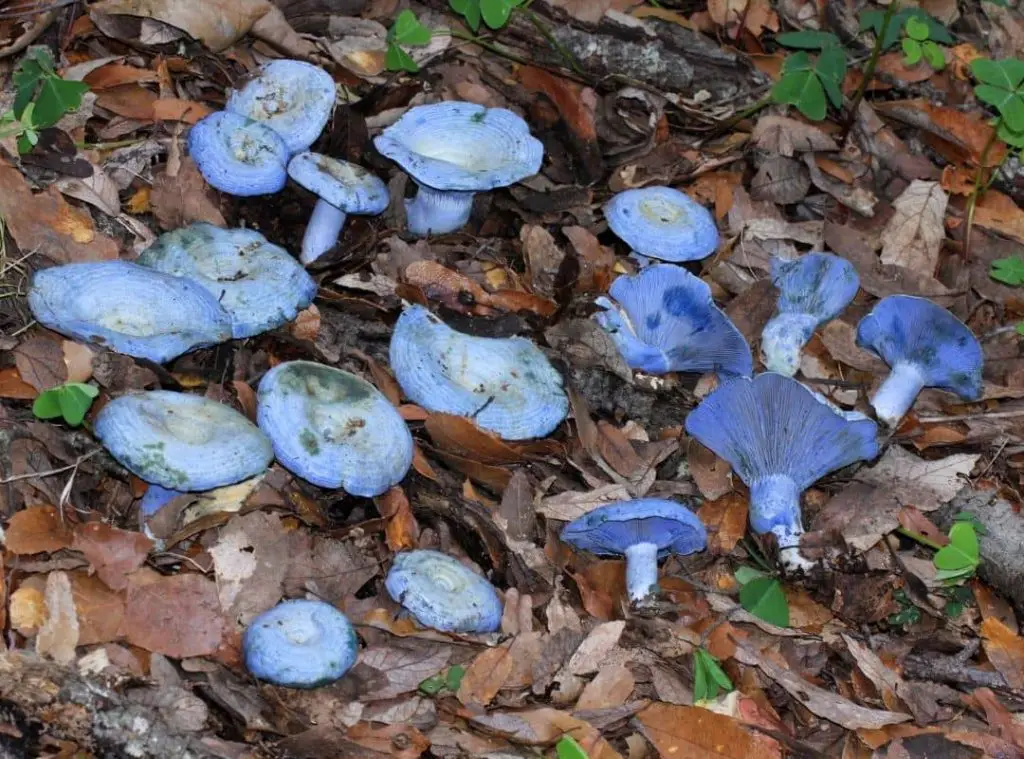
When can I find indigo milk caps?
Indigo milk caps grow during the late summer and fall. However, they have also been found in the spring. They often bloom after heavy rainfall.
Why are indigo milk caps blue?
A chemical called azulene causes the blue color of the Indigo Milk Cap. Indigo milk caps contain high levels of azulene, which is what gives them their blue color. Azulene is a natural dye that was once used to color fabrics and cosmetics. It is now used as a natural food coloring agent.
Can you eat an indigo milk cap?
Yes, you can eat Indigo Milk Caps. These mushrooms have a mild taste and are not poisonous. However, they may cause an upset stomach in some people. Although these mushrooms are safe to eat, some people have mild allergies to them. If you are allergic to mushrooms, you should not eat Indigo Milk Caps.
Is the blue milk cap mushroom poisonous?
No. Although most mushrooms in the Lactarius family are poisonous to humans, Indigo milk caps do not contain any poison that can harm humans. They are safe to eat and have a mild taste. However, they may cause an upset stomach in some people. This is because some individuals are allergic to mushrooms. If you are allergic to mushrooms, you should not eat Indigo Milk Caps.
What does an indigo milk cap taste like?
According to mushroom experts, indigo milk caps’ taste varies by the place it was picked. In general, they have a mild taste with a slightly nutty flavor. Some people say they taste like blueberries, while others taste like cabbage. However, they all agree that the taste is not very strong. However, the common flavor is said to be portobello.
How do you cook indigo milk caps?
Indigo milk caps can be cooked in many different ways. They can be sauteed, grilled, or even stir-fried. However, the most popular way to cook them is to fry them. Frying them gives them a crispy texture on the outside and a soft texture on the inside. When cooking Indigo Milk Caps, it is essential to remember that they contain a lot of water. This means that they will release a lot of water when cooked. You may need to add extra oil or butter to your pan when cooking them.
Otherwise, these mushrooms may stick to the pan and become difficult to flip. Indigo milk caps can be served with any type of food. They go well with meats, vegetables, and even pasta. However, they are usually served as a side dish.
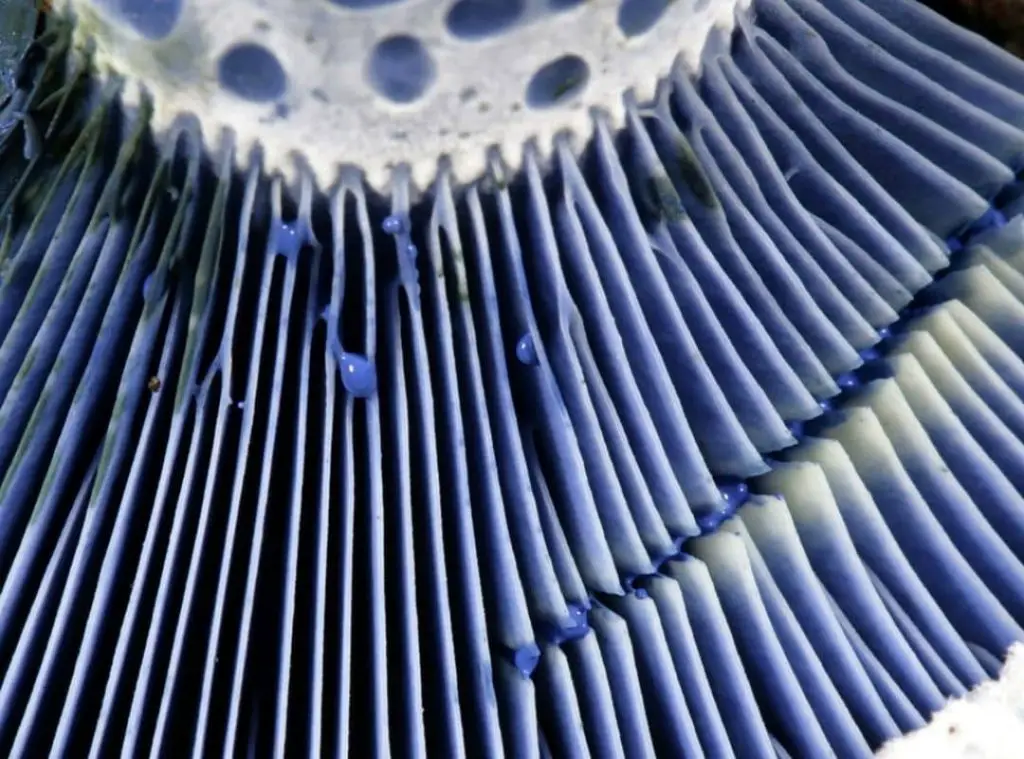
Do cooked indigo milk cap mushrooms retain their blue color?
The blue color of Indigo Milk Caps will usually fade when cooked. However, some people say that they retain their blue color better than other mushrooms. It all depends on how the mushrooms are cooked. If they are fried, then the blue color will usually fade. However, if they are cooked in a moist environment, the blue color may stay intact.
Tip: If you want to retain the color of indigo blue caps, you can blanch them in either salted water, an acid-like vinegar, or citric acid-like lemon juice before cooking.
Can you eat indigo milk caps raw?
Yes. You can eat an indigo milk cap raw as it is not poisonous. Raw indigo milk caps will have a mild taste, but it will be better to cook them first. This is because cooking helps to bring out the flavor of the mushroom. It also makes them more tender and easier to chew.
What is the nutritional value of indigo milk caps?
Indigo milk caps are a good source of proteins, vitamins, and minerals, and they are high in vitamin C, potassium, and phosphorus. They also contain dietary fiber, fatty acids, some B vitamins and minerals, such as zinc and iron. This means that they are a good source of nutrients for people looking for a healthy diet.
Are there any side effects to eating indigo milk caps?
Some people may experience an upset stomach after eating Indigo Milk Caps. This is because some individuals are allergic to mushrooms. If you are allergic to mushrooms, you should not eat Indigo Milk Caps. There are no additional known adverse effects associated with eating these mushrooms.
Indigo milk cap mushroom preservation
You can preserve these mushrooms in several ways. Drying them is the easiest and most popular method. To dry Indigo milk caps, cut them into slices and dry them in a dehydrator. You can also pickle them or can them. Slice them and put them in a jar with pickling juice to pickle them.
You can also use herb oil, white vinegar, or apple cider vinegar. To can them, put them in a jar with water and pressure cook them for 10 minutes. Then, store your mushrooms in a cool and dark place. You can also freeze them. To freeze them, slice them and put them in a freezer bag. However, some people do not like to preserve by freezing as it changes the texture of the mushroom.
Where can I buy indigo milk caps?
If you live in China, Gauthamala, or Mexico, you can buy Indigo milk caps from the local markets. However, if you live in other parts of the world, finding them may not be easy. You can try looking for them online or contacting a local mushroom supplier.
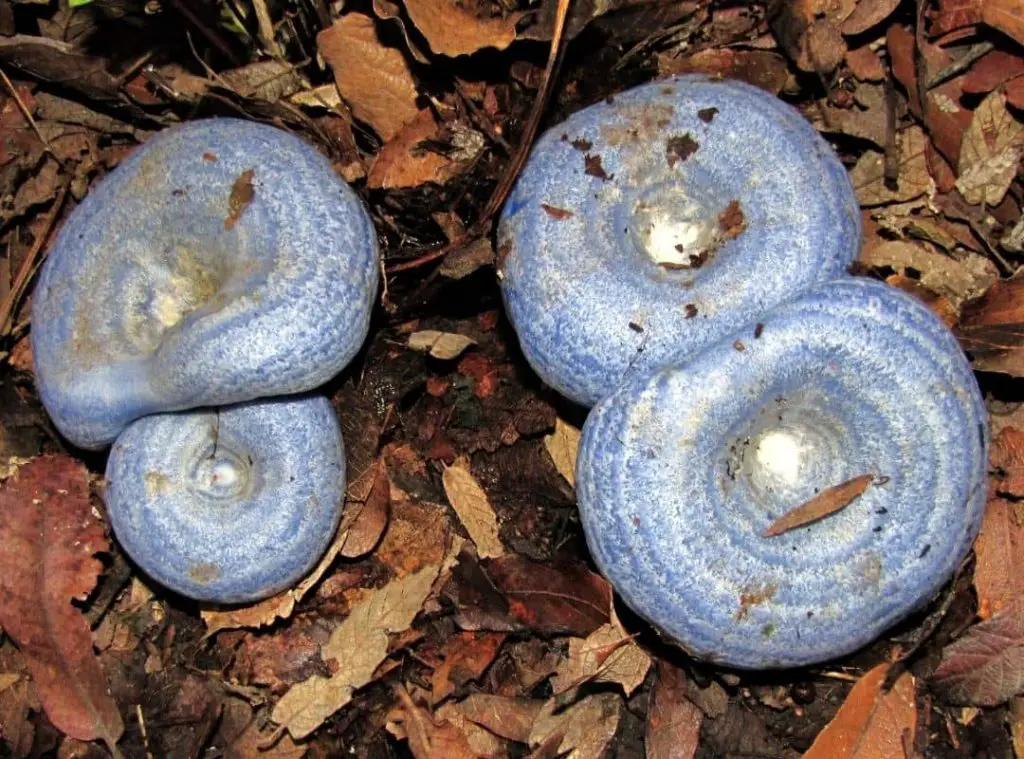
Do indigo milk caps have look-alikes?
Fortunately, the unique indigo color and the bluish milk-like latex make it hard not to recognize these mushrooms easily. However, there is a Cortinarius mushroom species with a bluish-purplish color that is poisonous to humans.
Still, it is easy to distinguish Indigo milk cap mushrooms from this look-alike since the latter does not ooze latex when its stem is cut. Further, the spore print of the indigo milk cap is creamy colored, while that of the poisonous Cortinarius is rusty-brown.
More interesting facts about Indigo Milk Caps
- Indigo milk caps have a symbiotic relationship (mycorrhizal) with certain trees. This means that the mushrooms depend on the tree for their survival. The mushroom gets its nutrients from the tree, and in return, it helps the tree absorb nutrients from the soil.
- Indigo milk caps are not used as a medicine, but some studies show that it has antibacterial and cytotoxic properties. This means that it could be used to develop new medicines in the future.
- Some studies suggest that the chemical found in Indigo milk caps can be used to make a fluorescent dye, which may be helpful in the medicinal industry as a diagnostic tool.
- Some believe that they can also use the color in this mushroom to dye textiles.
- The extract from Indigo milk caps is known to have anti-microbial properties, which can be used to inhibit some cancerous cells. But, these researches are still in their preliminary stages.
- Some Indigo milk caps have a slightly bitter or peppery taste. But, this does not indicate a problem as they are still safe to eat.
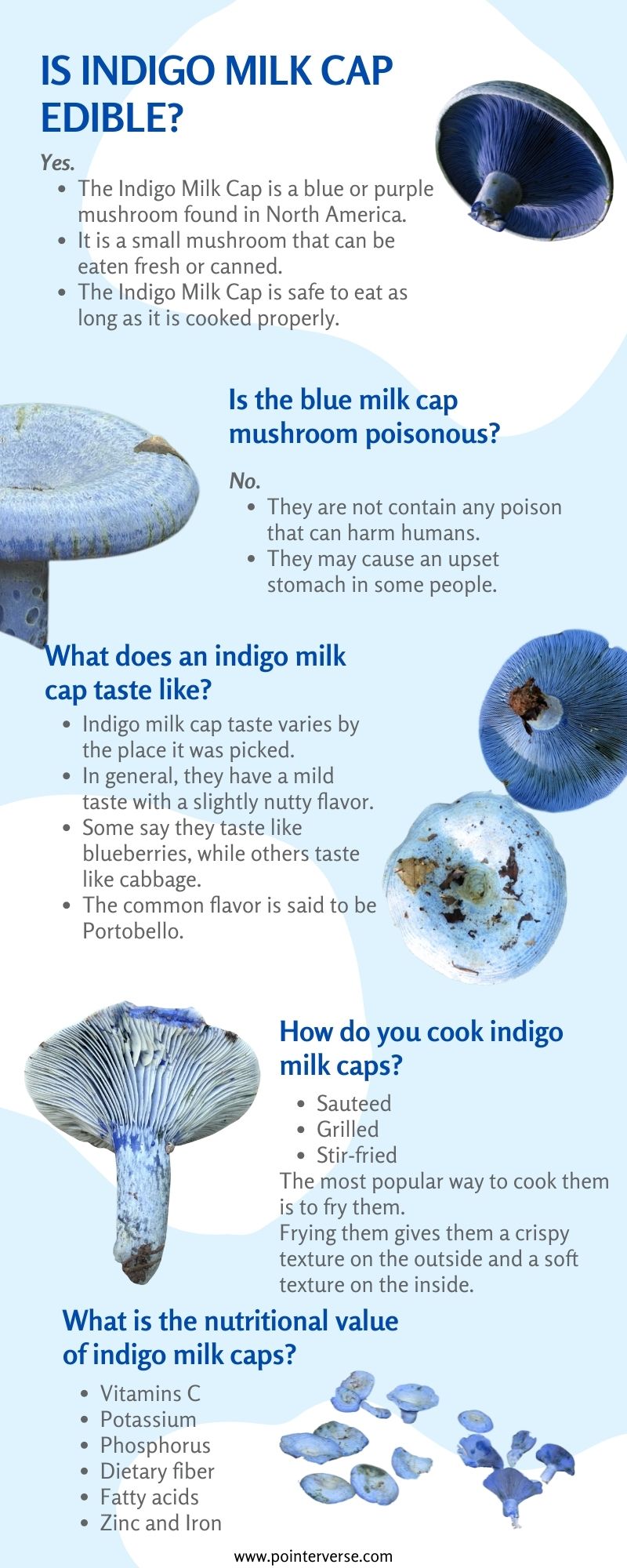
Related questions
Are indigo milk caps rare?
No, Indigo Milk Caps are not rare. They are widespread and can be found in many different parts of the world. However, it is an uncommon type of mushroom which you can not find just about anywhere.
Do indigo milk caps taste like portobello?
Some people say that Indigo Milk Caps taste like portobello. However, the taste of these mushrooms can vary depending on where they were picked. In general, they have a mild taste with a slightly nutty flavor.
Conclusion
Indigo milk caps are an edible mushroom type with an aesthetic blue color. It is a good source of nutrients and has several potential health benefits. However, more studies are needed to confirm these benefits. If you are hypersensitive to mushrooms, you should not eat Indigo milk caps. Otherwise, they are safe to consume. You can try cooking them in different ways to enjoy their taste. However, they are not as delicious as some other mushrooms. But, they can be used as decoration to make your dish more attractive.
You might have difficulty finding these mushrooms since they are not so common. But, you can try looking for them in local markets or online stores. You can also contact a local mushroom supplier to get them.
Credit to : How Long Does It Take For Morels To Grow ? ( 2 Weeks!! )

